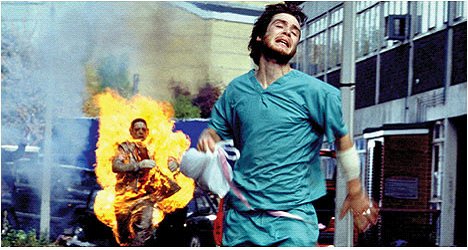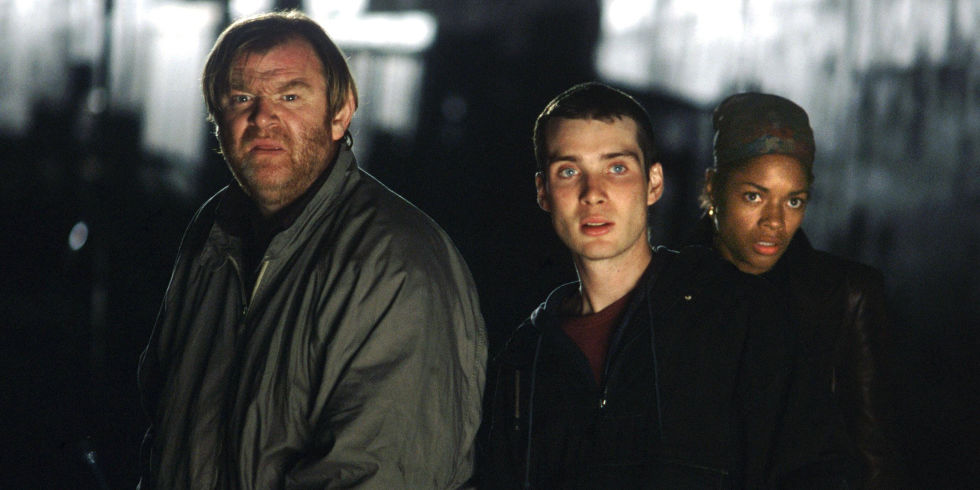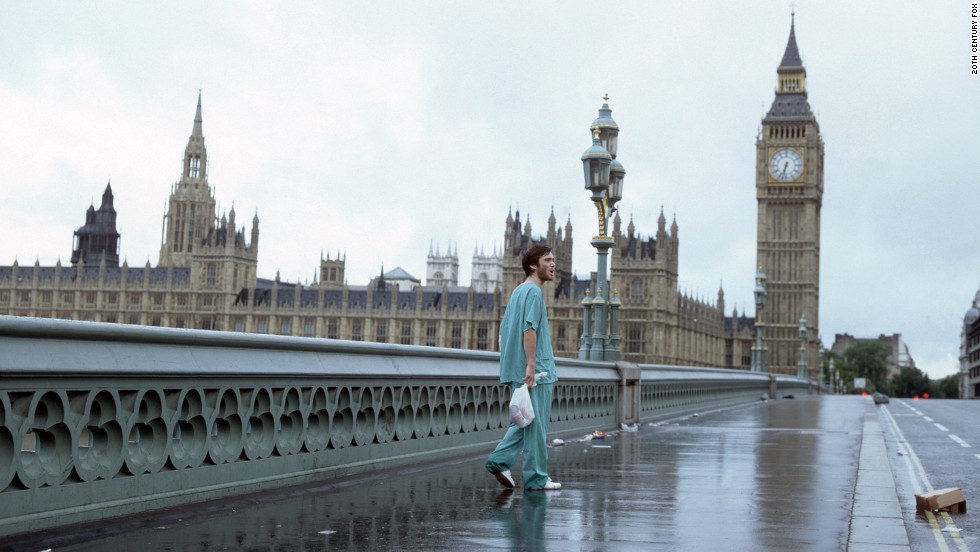28 Days Later (2003)
CAST:
Cillian Murphy, Naomie Harris, Brendan Gleeson, Megan Burns, Christopher Eccleston, Noah Huntley
REVIEW:
Hailed as one of the most frightening movies ever made, 28 Days Later is one in a long series of films addressing mankind’s fear of and fascination with the end- a catastrophic apocalypse that nearly wipes out the human race, but in a different vein than most. Director Danny Boyle’s and screenwriter Alex Garland’s vision of the end isn’t nuclear war or environmental disaster, but disease, specifically a genetically engineered virus known as rage. One drop of infected blood and the victim is almost instantly driven into a berserk frenzy by uncontrollable rage. This leads to it generally being considered a zombie movie, but this isn’t your daddy’s zombie movie, where the decaying walking dead somehow manage to get the petrified victims despite moving like molasses. The zombies here are fast, vicious predators, the characters are three-dimensional individuals rather than cardboard zombie food, and the filmmakers supply a little depth alongside scaring the living crap out of the audience. The result is that rare breed, a film that is both smart and scary.
After a chilling prologue showing the origin of the plague, with misguided animal rights activists breaking into a Cambridge laboratory and releasing infected chimpanzees, we jump ahead twenty-eight days later, when Jim (Cillian Murphy), a mild-mannered courier, awakens from a coma from before the epidemic started to find the hospital deserted and in disarray. No doctors. No patients. Jim can’t understand what’s going on, and things only get worse when he emerges into an utterly deserted, silent London. In what must have been a difficult series of shots to organize in the normally bustling British capital, we see our increasingly confused protagonist wandering around Piccadilly Circus and across London Bridge with not a soul in sight, until he has his first encounter with ‘the infected’- red-eyed, bloodthirsty subhuman creatures who roam the cities and countryside in packs, hunting down and savagely mauling any person they come across. This raises the question of why they don’t attack each other, but the relentless series of hair-raising sequences ensures that you don’t spend too much time wondering about small details. Jim is saved by two other survivors, Mark (Noah Huntley), and Selena (Naomie Harris), a hard-nosed survivalist who preaches a hard line. ‘Survival’s as good as it gets’, she insists at one point, and at another she flatly informs Jim that if anyone, including him, slows her down, she’ll leave them behind in a heartbeat. They tell Jim the nightmarish truth- that Britain was overrun by the rage virus and the entire population has either been infected or evacuated, and they are cut off from the rest of the world. Under nearly constant danger of attack from roaming infecteds, they end up banding together with a big, genial man named Frank (Brendan Gleeson) and his young daughter Hannah (Megan Burns), who have picked up radio signals from a last remaining army base under the command of Major Henry West (Christopher Eccleston), and want to try for it.
 28 Days Later starts out as a quirky, unconventional but highly effective horror movie, then turns into a road movie, and ends up as a more straightforward action-thriller. But for its entire running length, this is a creepy movie that supplies a steady succession of sequences capable of raising the nape hairs. And it’s not a mindless series of jolts either. Danny Boyle and Alex Garland slip in a few hard-to-miss messages or questions about human nature, such as whether man is naturally inclined to killing and violence, and whether the virus brings something to the surface that we all have buried inside somewhere. Major West questions whether the infecteds killing people is so different from what people were already doing to each other in various parts of the world, and by the end the mild-mannered Jim unlocks some inner ferocity to come to the rescue of the other survivors. A few exchanges between Jim and Selena and the dubious “sanctuary” of the army base raises the question of whether it is worth it to survive if your humanity is abandoned along the way (this also a running theme of the zombie apocalypse television series The Walking Dead), and whether Major West and his men might be the real biggest “monsters” in the movie. In between the infecteds’ attacks, there are effective character-building scenes as the group of survivors bonds into a family unit of sorts and everyone realizes that simply surviving isn’t enough. They need each other, not only for pragmatic reasons, but emotionally as well. Even the touch of romance between Jim and Selena is born more of two people thrown together in a desperate situation needing human companionship than simple attraction. No one is a one-dimensional stock character. Jim, Selena, Frank, and Hannah are all believable individuals we can empathize with. And even Major West, while soon revealed as a man of questionable actions and motives, is more complicated than a generic “bad guy”.
28 Days Later starts out as a quirky, unconventional but highly effective horror movie, then turns into a road movie, and ends up as a more straightforward action-thriller. But for its entire running length, this is a creepy movie that supplies a steady succession of sequences capable of raising the nape hairs. And it’s not a mindless series of jolts either. Danny Boyle and Alex Garland slip in a few hard-to-miss messages or questions about human nature, such as whether man is naturally inclined to killing and violence, and whether the virus brings something to the surface that we all have buried inside somewhere. Major West questions whether the infecteds killing people is so different from what people were already doing to each other in various parts of the world, and by the end the mild-mannered Jim unlocks some inner ferocity to come to the rescue of the other survivors. A few exchanges between Jim and Selena and the dubious “sanctuary” of the army base raises the question of whether it is worth it to survive if your humanity is abandoned along the way (this also a running theme of the zombie apocalypse television series The Walking Dead), and whether Major West and his men might be the real biggest “monsters” in the movie. In between the infecteds’ attacks, there are effective character-building scenes as the group of survivors bonds into a family unit of sorts and everyone realizes that simply surviving isn’t enough. They need each other, not only for pragmatic reasons, but emotionally as well. Even the touch of romance between Jim and Selena is born more of two people thrown together in a desperate situation needing human companionship than simple attraction. No one is a one-dimensional stock character. Jim, Selena, Frank, and Hannah are all believable individuals we can empathize with. And even Major West, while soon revealed as a man of questionable actions and motives, is more complicated than a generic “bad guy”.
 The cast is fine, albeit lacking in name recognition (lead Cillian Murphy beat out more established contenders for the role of Jim, including Ewan McGregor, who previously starred for Danny Boyle in Trainspotting). The only two who might be recognizable to most viewers on this side of the Atlantic are Brendan Gleeson and Christopher Eccleston, and they’re character actors, not A-listers. This is not a detriment; the ensemble give solid performances, and their relative anonymity might actually make it easier to become absorbed in the story. When we meet Jim and Selena, the actors are unfamiliar to us, so we instantly see them simply as their characters, with no baggage or preconceptions, and this is not dispelled even when a moderately recognizable face like Brendan Gleeson shows up. Cillian Murphy is fine as Jim, an everyday Joe bewildered by the frightening new world he wakes up in, although it’s hard to deny that there are times, with his penetrating eyes, when Murphy looks a little creepy himself. The best member of the cast might be Naomie Harris. We see that Selena is not as cold or inhumane as she lets on; she is an ordinary woman who has been forced to grow tough to survive. No one will mistake Selena for a mere damsel in distress. Brendan Gleeson, sometimes pigeonholed into one-dimensional villains, is strong and likable as the amiable Frank, who hasn’t let the plague dampen his spirits, and Megan Burns as Hannah holds her own with her adult co-stars. And finally, Christopher Eccleston, a highly-regarded stage and screen actor in his native Britain and vaguely reminiscent of Ralph Fiennes, basically serves as the “villain” (although he doesn’t show up for quite a while) but he does it without sneering or twirling his mustache. Major West does some cruel things, but his motives, while misguided, aren’t as simple as malice or sadism.
The cast is fine, albeit lacking in name recognition (lead Cillian Murphy beat out more established contenders for the role of Jim, including Ewan McGregor, who previously starred for Danny Boyle in Trainspotting). The only two who might be recognizable to most viewers on this side of the Atlantic are Brendan Gleeson and Christopher Eccleston, and they’re character actors, not A-listers. This is not a detriment; the ensemble give solid performances, and their relative anonymity might actually make it easier to become absorbed in the story. When we meet Jim and Selena, the actors are unfamiliar to us, so we instantly see them simply as their characters, with no baggage or preconceptions, and this is not dispelled even when a moderately recognizable face like Brendan Gleeson shows up. Cillian Murphy is fine as Jim, an everyday Joe bewildered by the frightening new world he wakes up in, although it’s hard to deny that there are times, with his penetrating eyes, when Murphy looks a little creepy himself. The best member of the cast might be Naomie Harris. We see that Selena is not as cold or inhumane as she lets on; she is an ordinary woman who has been forced to grow tough to survive. No one will mistake Selena for a mere damsel in distress. Brendan Gleeson, sometimes pigeonholed into one-dimensional villains, is strong and likable as the amiable Frank, who hasn’t let the plague dampen his spirits, and Megan Burns as Hannah holds her own with her adult co-stars. And finally, Christopher Eccleston, a highly-regarded stage and screen actor in his native Britain and vaguely reminiscent of Ralph Fiennes, basically serves as the “villain” (although he doesn’t show up for quite a while) but he does it without sneering or twirling his mustache. Major West does some cruel things, but his motives, while misguided, aren’t as simple as malice or sadism.
28 Days Later was filmed entirely on handheld digital video (partly an artistic choice on Boyle’s part, partly to help shave costs off its low budget), giving it an intentionally grainy, gritty, almost documentary-style feel. There are lots of shaky handheld camera shots that add to the immediacy and tension of some scenes, as well as ensuring that the camera doesn’t linger too long on the makeup of the ‘infected’ extras. With their red eyes and slathering faces, the infecteds are suitably creepy and grotesque, and when their attacks come, they are swift and brutal. There is one sequence in particular, as the humans find themselves in a dark underground tunnel with a flat tire and a horde of infecteds coming their way that generates as much nail-biting tension as any thriller that comes to mind. The fact that we never know any more than the characters do about the larger situation adds to the feeling of isolation and desperation. What is happening in the rest of the world? Is there a “rest of the world”? They don’t know, and neither do we, at least not for a long time.
28 Days Later is about the most solid example you’re going to find of this kind of movie, successfully mixing nail-biting terror with a little bit of depth and effective character development. The movie is relentlessly tension-packed and often genuinely scary, but what makes it exceptional is that the characters are three-dimensional individuals rather than cardboard cutouts. The chills are broken up by a few moments of quirky humor and character development, the ‘villains’ have credible reasons for acting the way they do, and the ending doesn’t come across as forced or a cop-out. While it might not be immediately obvious, underneath all the blood-splattered horror, there’s the presence of both a brain and a heart.
***
